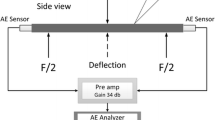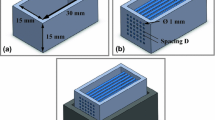Abstract
Formation of distributed cracking and the associated degradation in the stiffness of fabric-cement composites under tensile loading were studied. Composites made from low modulus woven polyethylene fabric and bonded Alkali Resistant (AR) glass mesh were manufactured by means of pultrusion technique. The influence of fabric type, matrix modification and curing as well as the pressure applied after pultrusion were studied using tensile stress strain response. Three distinct measures of damage including quantitative crack spacing by image analysis, stiffness degradation, and microstructural observation by optical and scanning electron microscopy are evaluated. The evolution of crack spacing as a function of applied strain was correlated with the tensile response as well as with the stiffness degradation for various composites. Also, the microstructure of the different composites was characterized and correlated with their mechanical properties using optical and scanning electron microscopy. It was observed that the mechanical properties as well as crack spacing and composite stiffness were significantly affected by the matrix formulation, curing procedure, and the intensity of the pressure applied after the pultrusion process. The best tensile performance was achieved for glass fabric composites with a high content of fly ash.
Similar content being viewed by others
References
Swamy RN, Hussin MW (1990) Continuous woven polypropylene mat reinforced cement composites for applications in building construction. In Textile Composites in Building Construction, Hamelin P, Verchery G (Eds.), Part 1, pp. 57–67.
Perez-Pena M, Mobasher B, Alfrejd MA (Dec. 1991) Influence of pozzolans on the tensile behavior of reinforced lightweight concrete. Materials Research Society, Innovations in the Development and Characterization of Materials for Infrastructure. Boston,MA.
Kruger M, Ozbolt J, Reinhardt HW (2003) A new 3D discrete bond model to study the influence of bond on structural performance of thin reinforced and prestressed concrete plates. Proceeding of the Fourth International RILEM Workshop on High Performance Fiber Reinforced Cement Composites (HPFRCC4). Naaman AE, Reindhart HW, (Eds) Ann Arbor, pp. 49–63.
Meyer C, Vilkner G (2003) Glass concrete thin sheets prestressed with aramid fiber mesh. Proceeding of the Fourth International RILEM Workshop on High Performance Fiber Reinforced Cement Composites (HPFRCC4), Naaman AE, Reindhart HW, (Eds). Ann Arbor, pp. 325–336.
Häußler-Combe U, Jesse F, Curbach M (2004) Textile reinforced concrete - overview, experimental and theoretical investigations. In: Li VC et al. (Eds) Fracture Mechanics of Concrete Structures. Proceedings of the fifth International Conference on Fracture Mechanics of Concrete and Concrete Structures/Vail, Colorado/USA/12-16 April. Ia-FraMCos, 204, pp. 749–756.
Bentur A, Peled A, Yankelevsky D (1997) Enhanced bonding of low modulus polymer fibers-cement matrix by means of crimped geometry. Cement Concrete Research Journal 27(7): 1099–1111.
Peled A, Bentur A, Yankelevsky D (1999) Flexural performance of cementitious composites reinforced by woven fabrics. Materials in Civil Engineering (ASCE) November: 325–330
Peled A, Bentur A, Yankelevsky D (1998) Effects of woven fabrics geometry on the bonding performance of cementitious composites: mechanical performance. Advanced Cement Based Materials J 7: 20–27.
Peled A, Bentur A (2000) Geometrical characteristics and efficiency of textile fabrics for reinforcing composites. Cement and Concrete Research 30: 781–790.
Mobasher B, Pivacek A, Haupt GJ (1997) Cement based cross-ply laminates. Journal of Advanced Cement Based Materials 6: 144–152.
Peled A, Mobasher B (2005) Pultruded fabric–-cement composites. ACI Materials J 102(1): 15–23.
Kazuhisa S, Noayoshi K, Yasuo K (1998) Development of carbon fiber reinforced cement. Advanced Materials: The big Payoff National SAMPE Technical Conference, Publ. by SAMPE, Covina, CA, USA, 21: 789–802.
Nishigaki T, Suzuki K, Matuhashi T, Sasaki H (1991) High strength continuous carbon fiber reinforced cement composite (CFRC). Proceeding of the third international symposium on brittle matrix composites, Brandt AM, Marshall IH (Eds.), Warsaw, Poland, Elsevier Applied Science, pp. 344–355.
Jesse F, Curbach M (2004) A new approach for determining geometrical properties of glass fibre reinforcement in grc composites. In: di Prisco M, Felicetti R, Plizzari GA. Fibre-Reinforced Concretes: Proceedings of the Sixth International RILEM-Symposium BEFIB 2004. Varenna, 20.-22.9.2004RILEM, pp. 267–278
Ferraris CF, Obla KH, Hill R (2001) Influence of mineral admixtures on the rheology of cement paste and concrete. Cement and Concrete Research 31(2): 245–255.
Mane SA, Tixier R, Mobasher B (2001) Development and application of high performance concrete with blended coal flyash. Final Report, submitted to Salt River Project, Phoenix, AZ, pp. 70.
Mobasher B, Stang H, Shah SP (1990) Microcracking in fiber reinforced concrete. Cement and Concrete Research 20(5): 665–676.
Stang H, Mobasher B, Shah SP (1990) Quantitative damage characterization in polypropylene fiber reinforced concrete. Cement and Concrete Research 20(4): 540–558.
Pahalijani J (2004) An analytical and experimental study of fabric-reinforced, Cement-Based Laminated Composites. MS Thesis, Arizona State University.
Sueki S (2003) An analytical and experimental study of fabric-reinforced, cement-based laminated composites. Thesis (M.S.), Arizona State University.
Marikunte S, Aldea C, Shah SP (1997) Durability of glass fiber reinforced cement composites. Advanced Cement Based Materials 5: 100–108.
Aveston J, Cooper GA, Kelly A (1971) The properties of fiber composites. Paper 1, Conference Proceedings, National Physical Laboratory, IPC Science and Technology Press Ltd., Surrey, England, pp. 15–26.
Mobasher B, Shah SP (1989) Test parameters in toughness evaluation of glass fiber reinforced concrete panels. ACI Materials Journal, Sept-Oct. pp. 448–458.
Zhu W, Bartos PJM (1997) Assessment of interfacial microstructure and bond properties in aged GRC using a novel microindentation method. Cement and Concrete Research 27(11): 1701–1711.
Trtik P, Reeves CM, Bartos PJM (2000) Use of focused ion beam (FIB) techniques for production of diamond probe for nanotechnology-based single filament push-out tests. Journal of Materials Science Letters 19: 903–905.
Author information
Authors and Affiliations
Rights and permissions
About this article
Cite this article
Mobasher, B., Peled, A. & Pahilajani, J. Distributed cracking and stiffness degradation in fabric-cement composites. Mater Struct 39, 317–331 (2006). https://doi.org/10.1007/s11527-005-9005-8
Received:
Accepted:
Published:
Issue Date:
DOI: https://doi.org/10.1007/s11527-005-9005-8




